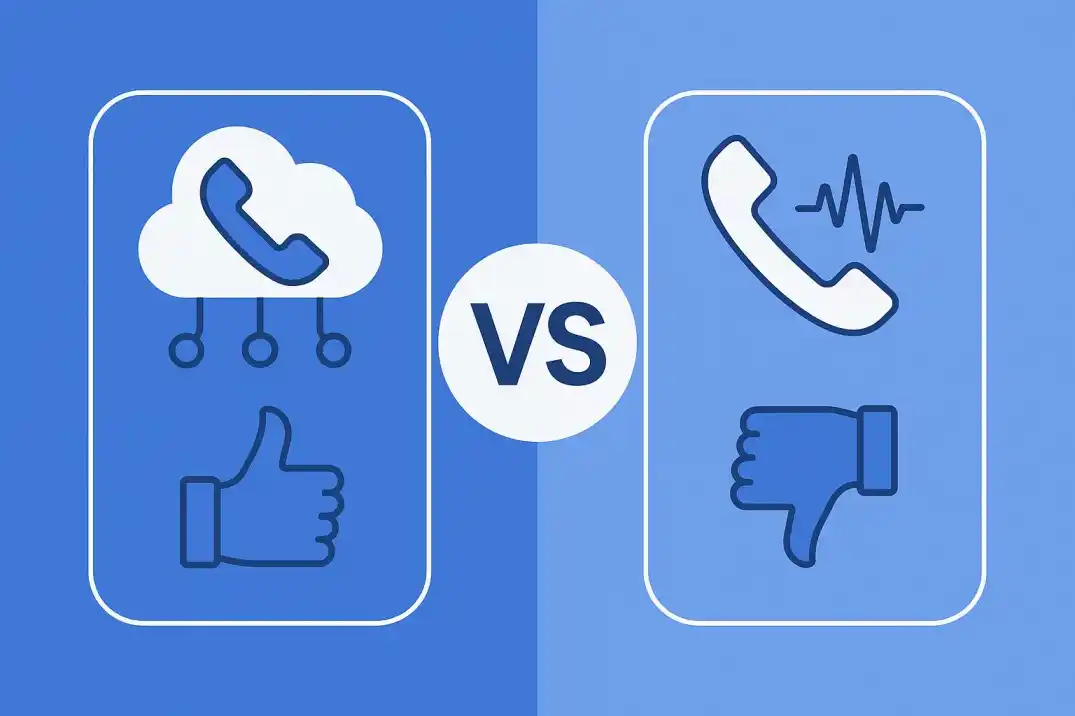Everyday we connect with many customers who confuse SIP Trunk & VoIP and today we'll be outlining the differences between VoIP and SIP trunking. We'll explain how each works and give you the pros and cons of both options. Let’s get right to it.
What is VoIP?
VoIP, or Voice over Internet Protocol, is a digital phone system technology that allows users to make voice calls over the Internet.
-
Unlike traditional phone systems, which use the Public Switched Telephone Network (PSTN) to make calls over wired landlines, VoIP enables voice communications by transmitting data packets wirelessly over Ethernet.
-
To put it simply: VoIP uses the Internet to make calls, while traditional landline phone systems use cable wires.
What is SIP Trunking?
SIP trunking is a phone system setup that connects an IP PBX system to both the Internet and the PSTN, allowing users to call any phone number by using just an Internet connection.
-
SIP = Session Initiation Protocol (it dictates the initiation and end of live data transfer sessions like VoIP).
-
SIP trunking enables IP PBX systems to connect SIP protocol functionality, and therefore VoIP, to the PSTN.
-
SIP trunking bridges the gap between local Internet calling on an IP PBX and non-local PSTN calls.
Most SIP trunk providers connect SIP and VoIP functionality to the IP PBX you already use, offering monthly payment structures with unlimited calling in North America and metered calling worldwide.
Key Difference Between SIP Trunking and VoIP
-
SIP trunking utilizes your on-site IP PBX system to provide VoIP and PSTN calling.
-
VoIP solutions are remotely hosted in the cloud by your VoIP telecom provider.
-
SIP trunking is a setup method; VoIP is the calling technology itself.
-
SIP trunking is one way to provide VoIP technology. You can’t have SIP trunking without VoIP, but you can have VoIP without SIP trunking.
Pros of VoIP
-
Easy to set up and maintain (especially hosted PBX VoIP services).
-
With cloud-hosted VoIP, you’re up and running in minutes.
-
Softphone functionality allows calls from phones or laptops—no extra hardware needed.
-
Cost savings: eliminates monthly PSTN bills, offers unlimited US/Canada calling, includes bundled features (conference calling, routing, etc.).
-
More scalable than legacy PBX—easily add/remove users and manage numbers virtually.
-
DID numbers can be purchased and cancelled quickly.
-
Advanced features often included:
-
IVR menus
-
Call queues
-
Skills-based routing
-
Voicemail transcription
-
Easy integration with CRMs, UCaaS, collaboration apps, and calendars.
-
Increased mobility: make business calls from anywhere with Internet access (coffee shop, home, vacation, car, etc.).
Cons of VoIP
-
Requires Internet—no calls during outages or power failures.
-
Pricing plans usually come in bundles, meaning you may pay for features you don’t need (like fax).
-
If you already have on-site PBX hardware, it may go unused when switching to hosted VoIP.
-
Setup may have initial costs, but long-term savings are significant.
Pros of SIP Trunking
-
Integrates with other tools (UCaaS, CCaaS, CPaaS platforms).
-
Add-on features: toll-free numbers, local numbers, custom area codes, call recording, call analytics.
-
Toll-free and local numbers help build a presence nationwide and globally.
-
Better call quality (HD voice with codec software).
-
Cost-effective subscription plans with unlimited US/Canada calling.
-
No additional hardware needed—just IP PBX and Internet.
-
Agents can use softphones on computers or mobiles.
Cons of SIP Trunking
-
Security risks (since calls transmit as data packets); needs proper firewalls and setup.
-
High bandwidth consumption, especially for call centers with video conferencing and heavy app usage.
-
May require more powerful routers or QoS settings.
-
Fewer features compared to VoIP (VoIP plans usually offer better value).
When to Use VoIP
-
If you don’t already have an IP PBX.
-
If you want cloud-hosted solutions without hardware costs.
-
If you need multiple channels (voice, SMS, team chat, etc.) in one app.
-
If you require complex routing and queuing, which is easier to manage virtually.
When to Use SIP Trunking
-
If you already have an IP PBX on site.
-
If you want to add VoIP functionality to your existing system.
-
If you already use UCaaS or collaboration tools and want to enhance them with VoIP calling.
If you want SIP Trunk or Hosted PBX, connect with CloudConnect.
CloudConnect is India’s first licensed B2B Virtual Network Operator (VNO), trusted by 350+ enterprises to power their communication. With secure and scalable cloud-based solutions, CloudConnect helps businesses simplify communication, reduce costs, and boost customer satisfaction.
Whether you need SIP Trunking to connect your existing IP PBX or a fully hosted PBX solution for mobility and remote work, CloudConnect provides enterprise-grade reliability with advanced features like IVR, call analytics, and seamless integrations.


